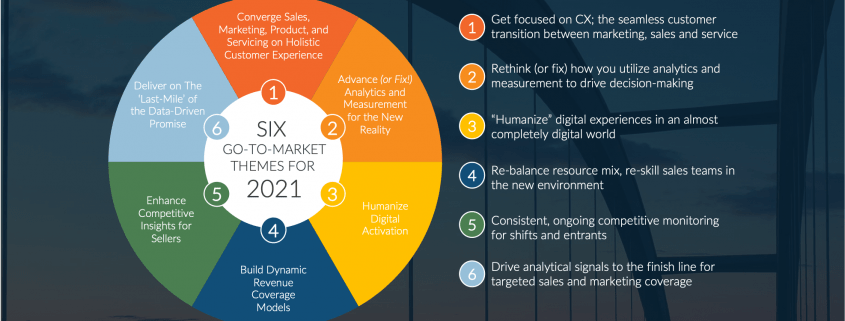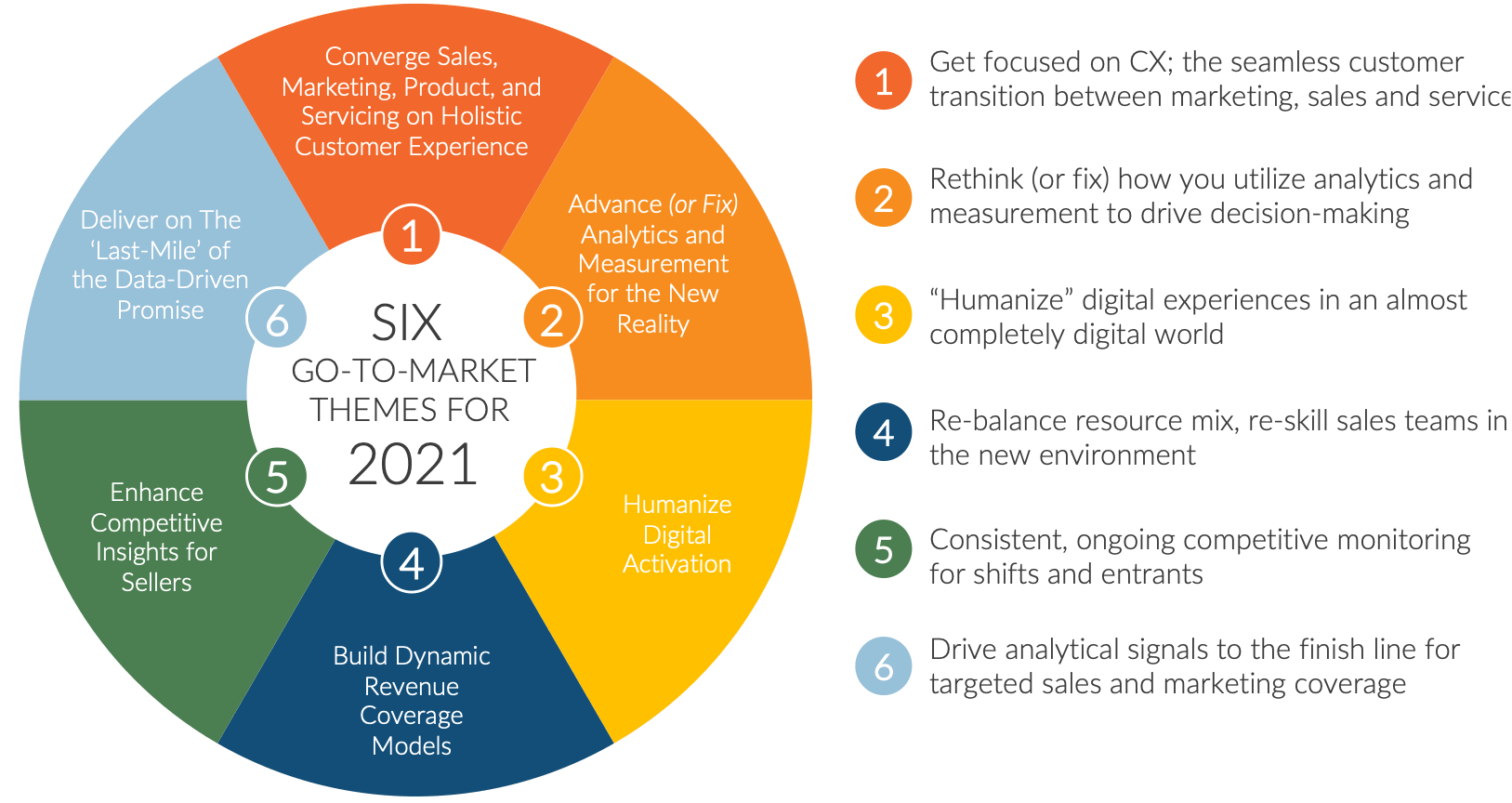Six Go-to-Market Themes for 2021 Success
With 2021 underway, and the world appearing to be transitioning from the pandemic, we took a look at how certain market trends are crystallizing going forward. Furthermore, thinking through the critical go-to-market adjustments needed as firms transition back towards a steady-state. We identified 6 key market trends and themes for revenue leaders to understand and react to. A number of these themes are advancements of topics we previously discussed in our Revenue Reboot Series series, and a few are newly identified.
1) Converge Sales, Marketing, Product, and Servicing on Holistic Customer Experience
We’ve seen some significant buyer journey changes over the past year, not only the rise in remote working, but a preference toward trusted brands over new and innovative, the surge in e-commerce, and reprioritizing of personal and business needs.1 What’s clear is customers are increasing the amount of buying diligence they conduct early in a process, and, perhaps more significantly, the merging of home and work has resulted in a convergence of B2B buying behaviors with complex B2C purchases.
Winning in this new environment takes a maniacal focus on the customer experience. Not only is the competitive landscape larger, but the engagements that customers are having on platforms like Amazon in their own personal life, are now expected in the B2B world. Exceptional customer experience requires a seamless transition for the customer between marketing (awareness), sales (interest and purchase), servicing, and product s/value delivery(training, loyalty, and beyond). Breaking down the silos between these organizational divisions will be critical to ensure the customer is receiving a personalized and seamless experience from start to finish (or ending in cross-sell/upsell as most ideal!).
2) Advance (or Fix) Analytics and Measurement for the New Reality
When black swan market events occur, most analytic models become far less reliable if not completely unsuitable for their original use. This was certainly the case over the last 12-months for both performance attribution (MMM, MTA, etc.) and discrete customer models (renewal models, buyer propensities, etc.). In response, businesses need to rethink how they utilize their analytics and measurement to drive decision-making. Specifically, in order to manage through these turbulent times, marketing and analytics teams must turn to two specific tactics: 1) existing predictive model calibration, and 2) developing simpler descriptive, direct analyses. For item one, ensure your analytic team is evaluating various period weighting techniques and/or inclusion of new external controls to ensure as much of the insight from the post black swan event is captured. One digital media company identified user acquisition patterns directly linked to COVID infection rates, and without controlling for this, the true measurement of their marketing stimulus was severely impacted.
At the same time, (re)introduce the evaluation of simple, direct measurement methods to identify how tactics are changing. If your email marketing saw a simple decline of 20% response, this is enough insight to evaluate adjusting the tactic itself, rather than relying on the larger, multi-variate models that might have longer horizons to pick up changes. Shifting analytics towards fast, quick insights will help marketing and sales teams make smarter adjustments to market changes.
3) Humanize Digital Activation
With massive shifts in marketing channels due to COVID travel restrictions, we saw a shift from traditional engagements to digital touchpoints (e.g. conferences to digital events) along with an acceleration of broader digital marketing investments.
While digital event attendance/engagement increased initially, BrightTalk’s reports 35% said keeping an audience engaged on these digital events was their biggest challenge. Some are using digital events and webinars channels for the first time and are suffering from a steep learning curve around driving demand effectively.3 With these digital events now replacing face-to-face engagements as opposed to augmenting them, the challenge for B2B marketers going forward is to find ways to humanize digital experiences (more than just a talking head on a screen) more actively. Companies must shift from traditional webinar/presentation formats to more discussion-oriented methods like panels and roundtables. To do this effectively it will require marketers to shift their thinking from single, large-scale events to delivering more intimate, community/small-scale interactive digital engagements. The companies that can best bring back that “human” element to their digital marketing will find the most success in driving customer relationships moving forward.
4) Build Dynamic Revenue Coverage Models
The ripple effects of the pandemic will reverberate for some time. Opportunities in some industries will dry up just as quickly as others will pick up. Companies are increasingly forced to look at broader market plays than what they had been executing in ‘steady-state’. Rigid revenue coverage inhibits the agility needed to respond to rapidly changing markets.
The most obvious example of this is the speed at which most companies were forced to shift away from traditional face-to-face sales models. The reality is that most sellers over the last year, regardless of title, have been inside sales. Combine these kinds of trends with the massive shifts in various global markets, impacts on industries, and the massive acceleration of digital transformation efforts, and the addressable markets companies thought they were targeting a year ago likely look very different today. Ensuring that your coverage model adjusts to these differences is critical to ensure revenue capture going forward. Sales and marketing leaders need to re-balance their resource mix, re-skill their sales teams, and decide who fits where in the customer journey based on expertise and product knowledge.
5) Enhance Competitive Insights for Sellers
While many companies feel like they have been treading water along with their competitors, new entrants and quick strategic plays from the competition can and are altering the nature of markets quickly. Sellers on the front-line must be able to respond to these changes as buyers are quickly introduced to new solution paths.
In 2021, leading sales teams will have consistent, ongoing competitive monitoring in place focusing on identifying market shifts as well as the long-tail of upstarts. The faster you can identify competitive disruption, feed that knowledge into the front-line, the more buffer you will provide your product and marketing teams to catch up.
6) Deliver on The ‘Last-Mile’ of the Data-Driven Promise
Account-based marketing is probably the single largest B2B buzzword of the last three years. While the term itself is somewhat loaded, the broader concept of the ability to deliver tailored messaging and content to accounts and personas is a critical objective to get right. This is especially true when sales teams are forced to now “digitally” develop relationships. While most companies have been investing in various technologies supporting better identification of buyer signals and then directly target off those signals, the results are often not as substantial as anticipated. Given online everything that that this year has brought, the process in which you use those analytical signals (that tell you whom, what, where when to go after) will be critical.
The issue is not technology, but rather how marketing and sales converge. The promise of data-driven sales plays requires a much deeper connection with sales processes than typically exist today. Pivoting your marketing and sales teams to finally actuate the data-driven promise together will likely require putting them under “one roof” and shifting linear marketing and sales models to better acknowledge the complexity of the new customer journey.
As we look forward to 2021, market leaders will recognize the potential that comes from disruptive events. The move to put the customer at the center of their adjustments and ensuring their go-to-market channels are prepped with sufficient flex for response will provide lucrative opportunities. As in every post-downturn period, the return to growth will be dominated by those that proactively respond to the market before the path is fully cleared.
Reinvigorate your go-to-market strategy post disruption: a webinar series
Sales, Marketing and Customer Experience leaders are tasked at defining and building new go-to-market plans post-pandemic. Access our on-demand webinars providing essential strategies, frameworks and go-do’s to drive growth in the new economic environment.






